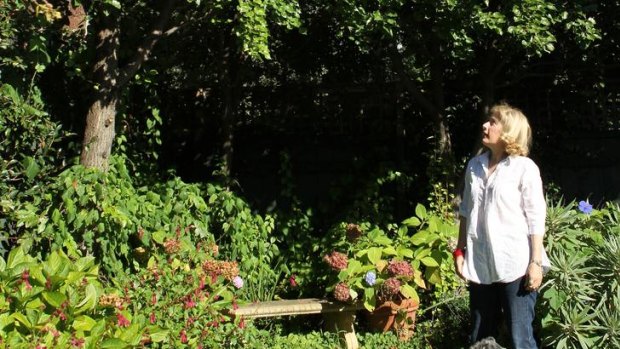By Denise Gadd
DURING the past decade the Manchurian pear has been the No.1 tree for landscaping.
An ornamental cultivar with heart-shaped leaves, scented white flowers and spectacular autumn foliage, Pyrus ussuriensis has the reputation of being the tree for all locations - massed along a fence to screen out neighbours, as a specimen tree in the middle of a park, lawn or circular drive, espaliered against a wall or as a pleached hedge a la Paul Bangay's signature designs.

Janet de Silva is concerned about the health of five Manchurian pear trees she planted 12 years ago.Credit: Rodger Cummins
Its attributes are many - form, flowers, foliage and fruit (inedible), an ability to withstand dry conditions and hold its leaves longer than many deciduous trees, fast growing in that it can create a dense mature hedge in five to six years - and those show-stopping red/crimson leaves in autumn.
But all is not well with some Manchurian pears. My neighbour lost three last year. An arborist was consulted but there didn't seem to be an answer. At first, I thought it was the armillaria fungus (root rot) that is rife in the bayside area but the telltale orange-gilled toadstools didn't appear in May-June, ruling out that theory. Or maybe it was a drainage problem brought about by so much rain around their roots after years of drought (Bangay's theory). Janet de Silva is wondering about the health of the five magnificent specimens of Manchurian pear she planted 12 years ago in her Elwood garden to screen out a block of flats. She loves the green canopies, autumn foliage, late winter-spring blossom - and, best of all - though deciduous, they're not bare for long.

But in December, like my friend's trees, the leaves developed their autumn colour, branches died back and then the leaves started dropping, revealing the pretty white buds underneath. All perfectly normal, except too early in the season for such horticultural activity.
De Silva contacted an arborist who says the die-back is related to possum damage and hot weather causing the stems to dry out, rather than a disease. He has suggested a good prune.
''If this is the case I'm relieved as I was concerned it could be fireblight [a contagious disease affecting apples, pears and some members of the Rosaceae family, which includes the Manchurian pear],'' de Silva says.
Duncan Hughes from Sandringham has the same problem with 18 four-year-old Manchurian pears. One tree has lost all its leaves and another is in autumn meltdown, but he lost another tree in the same area so it could be a drainage problem rather than a disease.
John Wilson, from the apple and pear division of Fruit Growers Victoria, says fire blight can affect ornamentals and some native trees. ''The canker gets into the blossom, or it can be an injury on the plant,'' he says. ''Telltale signs of the disease are the tips of the branches curl like a shepherd's crook.''
But he doubts whether de Silva's or Hughes' trees are affected by fire blight.
Another disease affecting trees in the state is the plant fungal pathogen myrtle rust, which has been detected in a number of Victorian sites. In January, the Department of Primary Industries, Victoria, confirmed the disease had been found within 100 kilometres of the Royal Botanic Gardens at Cranbourne and Melbourne, so a protocol was implemented to protect both botanic sites.
The disease attacks young, soft, actively growing leaves, shoot tips and young stems, plus the fruits and flowers of susceptible plants.